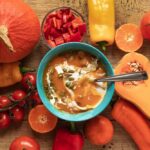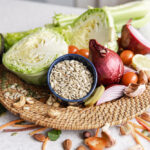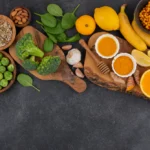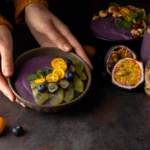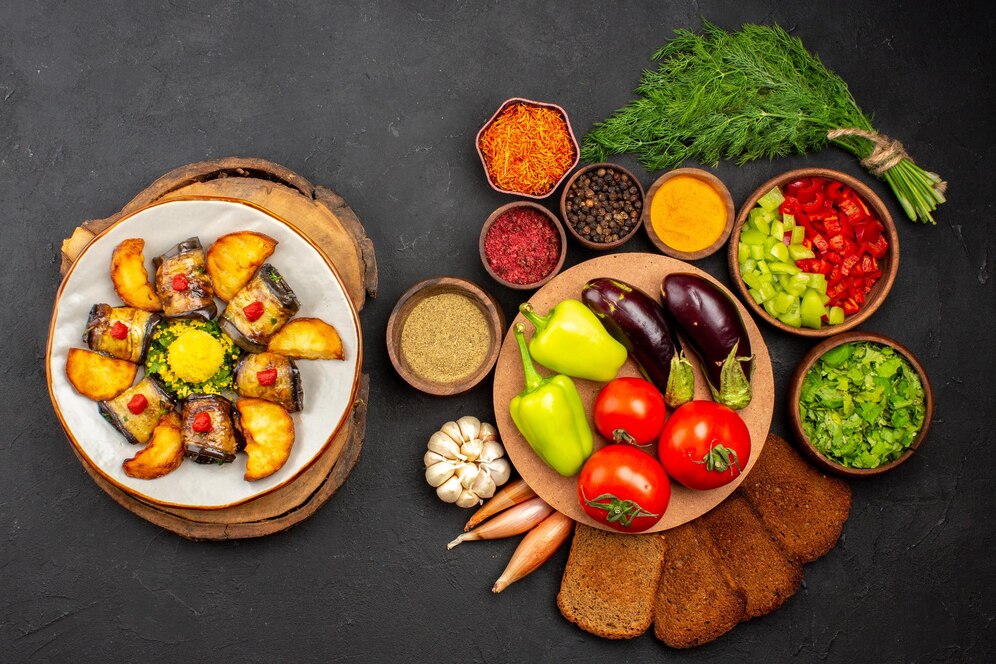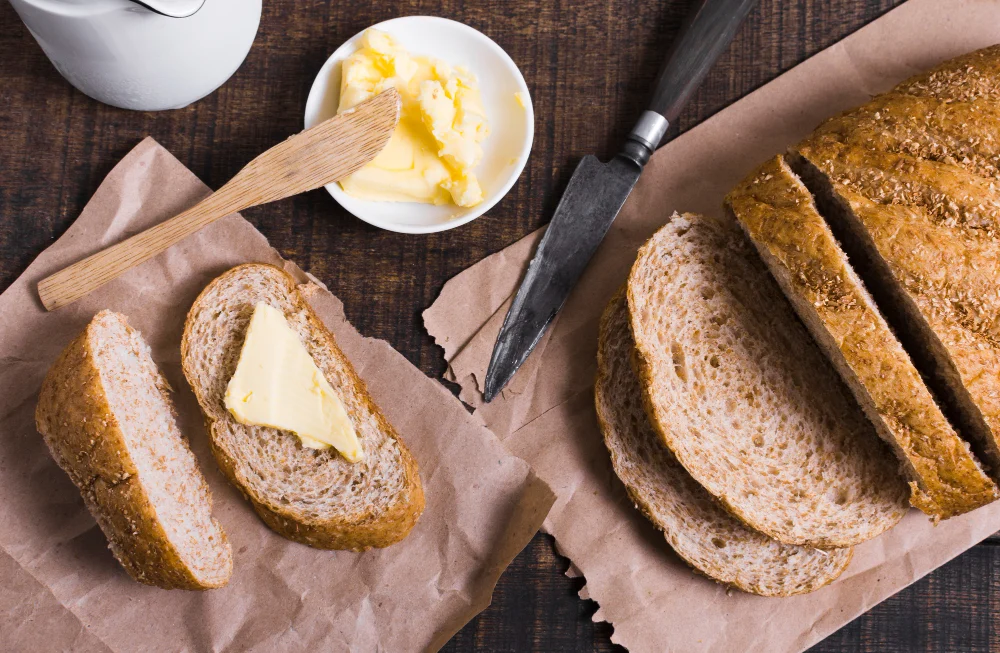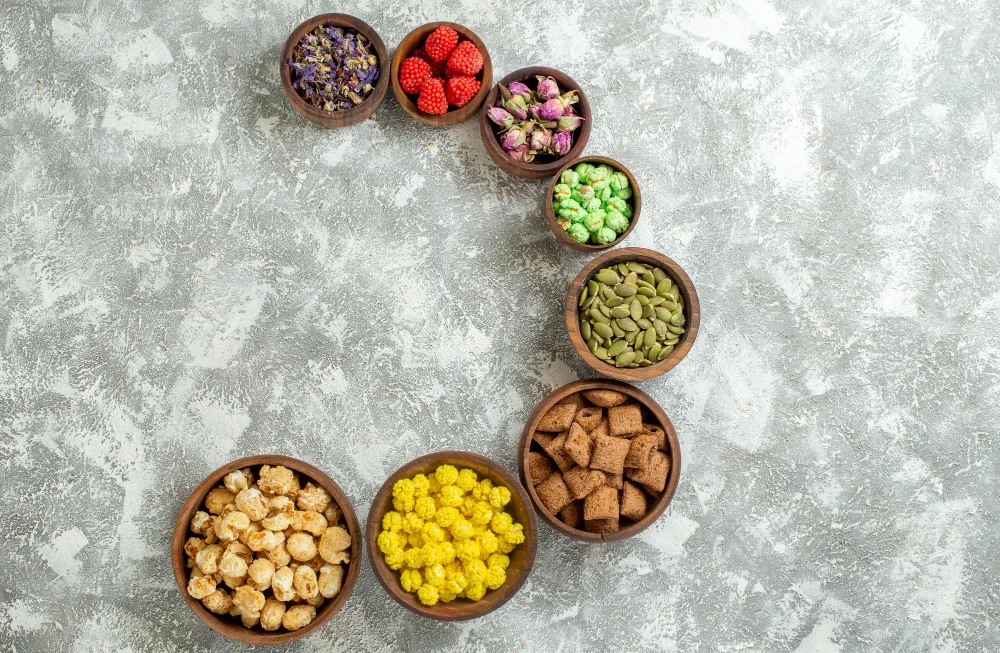Eating a balanced diet is fundamental to good health, providing sustained energy, essential nutrients, and overall well-being. For those following a vegan lifestyle, understanding how to combine plant-based foods effectively is key to ensuring nutritional completeness and satisfaction. This isn’t about complicated rules, but rather the art and science of vegan food pairings – strategically combining ingredients to maximize nutrient absorption, achieve protein completeness, and create delicious, hearty meals.
This guide explores the principles and practices of building balanced vegan plates and bowls, viewed through the lenses of nutritional synergy, ethical mindfulness, environmental harmony, and practical meal creation, with plenty of inspiration from Indian culinary wisdom and the local produce available here in Vadodara.
LENS 1: Nutritional Analysis (Synergy on a Plate)

Smart food pairing on a vegan diet goes beyond just taste; it unlocks greater nutritional benefits and ensures adequacy.
- Protein Completeness Myth vs. Reality: The old idea of needing to meticulously combine specific plant proteins (like beans and rice) at the same meal to get “complete protein” is largely outdated. While most plant proteins individually might be lower in one or two essential amino acids, eating a variety of protein sources – legumes (dal, chana, rajma), grains (rice, wheat, millets), nuts, seeds – throughout the day provides all the essential amino acids your body needs. Luckily, traditional Indian meals like Dal-Rice or Dal-Roti naturally achieve this combination anyway!
- Unlocking Iron Absorption: Plant-based iron (non-heme) isn’t absorbed as readily as heme iron from meat.
- The Skill: Pair iron-rich plant foods (lentils, chickpeas, beans, spinach/palak, tofu, pumpkin seeds) with sources of Vitamin C (lemon/nimbu juice, tomatoes/tamatar, amla/Indian gooseberry, bell peppers/shimla mirch, citrus fruits) in the same meal. Vitamin C dramatically enhances non-heme iron absorption. Conversely, avoid drinking tea or coffee with iron-rich meals, as tannins can inhibit absorption.
- Calcium Considerations: While plant sources exist (leafy greens, sesame seeds/til, ragi/finger millet, fortified foods), absorption can be influenced by factors like Vitamin D levels (ensure adequacy via sunlight/supplements) and compounds like oxalates (in spinach) and phytates (in grains/beans – reduced by soaking/sprouting/fermentation). Pairing calcium sources within a varied diet helps ensure overall intake.
- Fat-Soluble Vitamin Boost: Vitamins A, D, E, and K are fat-soluble, meaning they need fat to be absorbed properly.
- The Skill: Pair vegetables rich in these vitamins (e.g., carrots/gajar & sweet potatoes for beta-carotene/Vit A; leafy greens for Vit K) with a source of healthy fat (avocado, nuts, seeds, a drizzle of oil in cooking or dressing).
- Macronutrient Balance for Satiety & Energy: Combining complex carbohydrates (whole grains like brown rice or millet roti, starchy vegetables) with protein (legumes, tofu) and healthy fats (nuts, seeds, avocado, oils) leads to stable blood sugar, sustained energy release, and greater satiety compared to meals high in refined carbs alone. The traditional Indian thali, with its components of dal, rice/roti, sabzi (vegetable dish), and perhaps a little salad/pickle/yogurt (vegan version!), beautifully exemplifies this balanced approach. Remember B12 needs to come from fortified foods or supplements. What Vitamin C-rich food can you easily add to your next dal or bean dish to boost iron absorption?
Nutritional Deep Dive: Unlocking Plant Power – Key Nutrient Pairings
- Iron + Vitamin C:
- Why: Vitamin C converts non-heme iron into a more absorbable form.
- Examples: Squeezing lemon (nimbu) over dal or palak sabzi; adding tomatoes to chana masala; eating an orange or amla alongside a bean curry.
- Fat + Fat-Soluble Vitamins (A, D, E, K):
- Why: Dietary fat is required for the absorption of these vitamins in the intestine.
- Examples: Roasting carrots (Vit A precursor) with a little oil; adding nuts/seeds (Vit E, fat) to a leafy green salad (Vit K); using fortified oil or plant milk (Vit D) in cooking vegetables containing Vit A/K.
- Lysine (Amino Acid) + Methionine (Amino Acid):
- Why: Legumes are often lower in methionine, while grains are often lower in lysine. Combining them (e.g., Dal + Rice/Roti) provides a full complement of essential amino acids over the day.
- Note: This combining doesn’t need to happen strictly within the same meal as long as dietary variety is present daily.
Voice of Experience (Ayurvedic Nutrition Consultant): “The wisdom of traditional Indian food pairings often aligns with modern nutritional science. Combining dal with rice or roti ensures protein balance. Using lemon or tamarind with iron-rich greens aids absorption. Cooking vegetables with appropriate spices and healthy fats supports digestion and nutrient assimilation according to Ayurvedic principles of balancing tastes and properties.” – Vaidya Rekha Sharma, BAMS
LENS 2: Ethical Framework (Mindful Combinations)
 The way we combine foods to create meals can also reflect ethical considerations beyond just being vegan.
The way we combine foods to create meals can also reflect ethical considerations beyond just being vegan.
- Mindful Meal Creation: Thoughtfully pairing ingredients is an act of respecting the food and nourishing oneself and others with intention. It moves beyond convenience eating towards conscious nourishment, aligning with the ethical principle of self-care as part of a compassionate lifestyle.
- Ethical Sourcing Synergy: Choose pairings that utilize ethically sourced components – Fair Trade grains (rice, quinoa) paired with locally sourced vegetables from Vadodara markets, Fair Trade spices enhancing local legumes. This weaves ethical sourcing throughout the entire meal.
- Resourcefulness & Waste Reduction: Skillful pairing is key to minimizing food waste. Pair leftover cooked grains with freshly made dal or sabzi. Combine various leftover vegetables into a mixed sabzi or soup base. Use slightly wilted herbs blended into chutneys or dressings to pair with main dishes. This honours the resources used to produce the food.
- Simplicity & Sufficiency: Ethical eating can also involve resisting overconsumption. Focus on creating balanced, satisfying meals with simple, sufficient pairings rather than overly elaborate dishes requiring excessive ingredients or resources.
- Sharing & Hospitality: Offering well-balanced, thoughtfully paired vegan meals to guests is an act of compassionate hospitality, demonstrating care and showcasing the delicious possibilities of ethical eating. How can planning your meals around pairing leftovers with fresh components help you practice ethical waste reduction?
Hidden Benefits: Enhanced Culinary Appreciation
Learning about effective food pairings deepens one’s appreciation for how different ingredients interact, enhancing flavour, texture, and nutrition. It elevates cooking from mere assembly to a more thoughtful, synergistic art form.
Voice of Experience (Slow Food Advocate): “Mindful pairing is central to ethical eating. It means combining local, seasonal vegetables with sustainable staples like lentils or millets. It means pairing leftovers creatively to avoid waste. It’s about building meals that respect the ingredients, the farmer, the environment, and the person eating.” – Anand Patel, Slow Food Vadodara Chapter (hypothetical)
Critical Reassessment: Avoiding Rigidity
While pairings can optimize nutrition and flavour, avoid becoming overly rigid or dogmatic. Stressing about perfect combinations at every single meal is unnecessary (especially for protein) and can detract from the joy of eating. Focus on overall dietary patterns and variety throughout the day and week.
LENS 3: Ingredient Science & Environment (Sustainable Synergy)

Understanding the science behind ingredients and their environmental impact reveals the sustainable wisdom often embedded in traditional food pairings.
- The Science of Pairings:
- Flavor Chemistry: Acids (lemon, vinegar, tamarind/imli) cut through richness and brighten flavours. Fats carry fat-soluble flavour compounds from spices. Umami ingredients (tomatoes, mushrooms, soy sauce) create savoury depth. Skillful pairing considers these interactions.
- Texture Complementarity: Combining soft textures (dal, mashed potato) with crunchy elements (raw veg, toasted nuts/seeds, papad) makes meals more interesting.
- Nutrient Interactions: As discussed (Iron+C, Fat+Fat-soluble Vitamins).
- Environmental Synergy:
- Legume-Grain Power Duo: Legumes fix atmospheric nitrogen into the soil, reducing the need for synthetic fertilizers (which have a high energy footprint and cause pollution). Grains often benefit when rotated with legumes. This pairing (Dal-Rice, Dal-Roti, Bean-Corn) is thus inherently synergistic and sustainable from an agricultural perspective.
- Seasonal Vegetable Pairings: Using vegetables available locally in season (e.g., pairing summer gourds like lauki with moong dal, or winter greens like palak with chana in Vadodara) minimizes transport emissions and supports regional farming systems adapted to the local climate.
- Water Footprint Choices: Pairing dals or sabzis with water-efficient millets (bajra, jowar – ideal for Gujarat/Rajasthan) instead of water-intensive rice significantly reduces the meal’s overall water footprint.
- Reduced Processing Footprint: Building meals from simple pairings of whole grains, legumes, and vegetables has a lower processing energy footprint compared to meals relying on highly processed meat alternatives or sauces. How does the classic Indian pairing of Dal and Roti/Rice represent both nutritional synergy and environmental sustainability?
Market Transformation Map Suggestion: Data showing increased farmer/consumer interest in intercropping or crop rotation systems involving legumes and grains in India, promoted for soil health and sustainability. Or, increased market availability of diverse millet types alongside rice.
Voice of Experience (Sustainable Agriculture Expert): “Traditional agricultural systems often intuitively incorporated sustainable pairings. Legume-cereal rotations are fundamental for soil health and reduced fertilizer needs globally, including in India. Pairing meals based on these low-impact staples, combined with local seasonal vegetables, forms the bedrock of a truly sustainable food system.” – Dr. Ramesh Kumar, Agricultural Research Institute
LENS 4: Everyday Practitioner’s Experience (Building Balanced Bowls & Plates)

Let’s put theory into practice! Building balanced vegan meals is easy using simple pairing formulas and adapting traditional approaches like the Indian thali.
The Balanced Vegan Meal Formula:
- Foundation (Complex Carb/Grain): ~¼ – ⅓ of plate. Brown rice, whole wheat roti/chapati/bhakri, millets (bajra, jowar, ragi, quinoa), potatoes/sweet potatoes.
- Protein Power: ~¼ of plate. Lentils (dal), chickpeas (chana), kidney beans (rajma), black-eyed peas (lobia), tofu, tempeh, edamame, sprouts.
- Vegetable Variety: ~½ of plate. Non-starchy vegetables – cooked (sabzi) and/or raw (salad/kachumber). Aim for multiple colours! Use seasonal options (e.g., Vadodara summer: gourds, bhindi, tomatoes, onions, cucumber; Winter: carrots, peas, cauliflower, greens).
- Healthy Fats: Incorporated in cooking oil (used moderately), tadka, dressings, nuts/seeds sprinkled on top, avocado, coconut (in moderation).
- Flavour Accents: Spices, herbs, lemon/lime juice, pickles (achar), chutneys, vegan yogurt/raita.
Practical Pairing Examples (Indian Focus):
- The Classic Thali: Dal (Protein/Iron) + Rice/Roti (Carb/Fiber) + Mixed Veg Sabzi (Vitamins/Fiber) + Kachumber Salad (Vit C/Freshness) + optional Vegan Raita (Calcium if fortified) + Achar (Flavor). Perfectly balanced!
- Rajma Chawal Meal: Rajma Masala (Protein/Iron/Fiber) + Steamed Rice (Carb) + Side Salad with Lemon Dressing (Vit C).
- Chole Bhature/Roti Meal: Chana Masala (Protein/Iron/Fiber) + Bhatura (often fried, swap for whole wheat Roti for healthier option) + Raw Onion Rings & Lemon Wedges (Vit C).
- South Indian Meal: Idli/Dosa (Carb/Protein from fermented batter) + Sambar (Lentil/Veg Stew – Protein/Fiber/Vitamins – check no ghee) + Coconut Chutney (Fat/Flavor).
- Khichdi Meal: Rice + Moong Dal cooked together (Carb/Protein/Fiber) + side of Vegetable Sabzi or Vegan Kadhi (using plant yogurt/besan) + Papad/Pickle.
- Quick Bowl: Quinoa/Millet base + Roasted Chana + Leftover Sabzi + Handful of Peanuts + Green Chutney.
Tips for Effective Pairing:
- Think Thali: Use the Indian thali concept mentally – ensure you have a dal/legume, a grain, and vegetables in most main meals.
- Iron + C Habit: Make it routine to add lemon/lime juice, tomatoes, peppers, or amla to meals containing lentils, beans, or spinach.
- Don’t Overcomplicate: Simple pairings often work best. Dal-rice-sabzi is a nutritionally solid foundation.
- Meal Prep Components: Cook grains and beans in batches. Prep basic sabzi bases. This makes assembling balanced meals quick during the week.
- Snack Smart: Pair fruits with nuts/seeds; have hummus with veggie sticks.
What traditional Indian meal combination (like Dal-Roti or Idli-Sambar) already demonstrates good vegan food pairing principles?
Daily Impact: The Balanced Plate Visual
Mentally divide your plate: Half non-starchy vegetables/salad, one quarter protein (dal, beans, tofu), one quarter whole grain/starchy vegetable (rice, roti, potato). Drizzle with healthy fat/dressing. This visual makes balancing easy.
Voice of Experience (Indian Home Cook): “For me, a balanced vegan meal is just a normal Indian meal! We always have dal, some kind of sabzi with seasonal vegetables from the market here in Vadodara, and roti or rice. Maybe a small salad (kachumber) on the side. It naturally combines protein, carbs, and veggies. Just ensure no ghee or dairy is used in cooking.” – Mrs. Bharati Joshi, Homemaker

Alternative Approaches: One-Pot Wonders
Dishes like vegetable pulao (with added chana/peas/tofu), khichdi (with added vegetables), or hearty lentil soups/stews inherently combine grains, legumes, and vegetables, offering balance in a single pot.
PERSPECTIVE INTERSECTION MATRIX
- Nutrition & Tradition (Lens 1 & 4): Nutritional science often validates the balance found in traditional meal structures like the Indian thali (Lens 4), which pairs legumes, grains, and vegetables effectively (Lens 1).
- Ethics & Local Pairings (Lens 2 & 4): Choosing to pair local, seasonal vegetables with sustainable staples (Lens 4) aligns with ethical sourcing principles and supports local farmers (Lens 2, 3).
- Environment & Grain Choice (Lens 3 & 4): Pairing dals/sabzis with environmentally suitable grains like local millets instead of rice (Lens 4) is a practical application of sustainable principles (Lens 3).
- Science & Absorption (Lens 3 & 1/4): Understanding the science of nutrient synergy (Iron+C) (Lens 1, 3) informs practical meal pairings for better absorption (Lens 4).
- Practicality & Balance (Lens 4 & 1): Simple pairing formulas and meal prep techniques (Lens 4) make achieving consistent nutritional balance (Lens 1) feasible in daily life.
MISCONCEPTION ANALYSIS
| Misconception | Reality |
| Vegans need to carefully combine specific plant proteins at every single meal. | Outdated Myth. While combining sources like legumes and grains provides a full amino acid profile, this balance needs to be achieved over the course of the day, not necessarily in one sitting. Eating a varied diet naturally covers needs. Traditional pairings often do it anyway. |
| Vegan meals are inherently less balanced or nutritious than omnivorous meals. | False. Well-planned vegan meals focusing on whole foods and smart pairings (legumes, grains, abundant veg, nuts/seeds) are often more nutrient-dense, higher in fiber, and lower in saturated fat/cholesterol than typical omnivorous meals. Planning is key for any diet. |
| Figuring out balanced vegan food pairings is complicated and difficult. | It can be made simple! Following basic formulas (Grain+Legume+Veg+Fat) or traditional meal structures (like the Indian thali) naturally creates balance. Focus on variety and including key food groups. |
| Balanced, healthy vegan meals must be bland or boring. | Absolutely not! Flavor comes from skillful use of spices, herbs, aromatics, sauces, dressings, and cooking techniques. Balanced meals using diverse plant ingredients offer incredible taste possibilities, especially in flavourful cuisines like Indian. |
| You need supplements (beyond B12) for everything if you pair foods wrong. | While B12 is essential, smart food pairings (like Iron+Vit C) significantly enhance absorption of nutrients from food itself, reducing the need for other supplements if a varied diet is consumed. Focus on food first. |
KEY TURNING POINTS
- Discovery of Essential Amino Acids: Led to initial (now outdated) theories about needing strict protein combining at each meal.
- Understanding Nutrient Synergies: Research revealing how certain nutrients enhance absorption of others (e.g., Vitamin C boosting iron absorption).
- The “Food Combining” Diet Fad (and its debunking): While mostly pseudoscientific, it raised general awareness about how foods interact, paving the way for evidence-based pairing discussions.
- Popularization of the “Plate Method”: Visual guide (often used for diabetes management but applicable generally) emphasizing balanced proportions of food groups.
- Recognition of Traditional Dietary Wisdom: Increased appreciation for the inherent nutritional balance found in traditional eating patterns like the Mediterranean diet or the Indian thali.
- Rise of “Bowl” Meals: Popular format encouraging conscious combination of grains, proteins, vegetables, and toppings.
SYNTHESIS & RECOMMENDATIONS
Creating balanced meals with vegan food pairings is less about rigid rules and more about developing an intuitive skill based on nutritional wisdom and culinary creativity. By understanding how to combine plant-based staples like legumes, whole grains (including local Indian millets!), colourful seasonal vegetables, and healthy fats, you can easily craft meals that are not only nutritionally complete and highly satisfying but also ethically sound and environmentally conscious. Embrace simple formulas, draw inspiration from balanced traditional meals like the Indian thali, and focus on variety throughout your day and week. Mastering these pairings transforms vegan eating from simple substitution into a truly nourishing and delicious lifestyle art form.
Recommendations for Mastering Vegan Food Pairings:
- Think in Components: Mentally structure meals around: Grain/Starch + Protein (Legume/Tofu/etc.) + Lots of Veggies + Healthy Fat + Flavor.
- Pair Iron & Vitamin C: Consciously add lemon/lime juice, tomatoes, peppers, or amla to meals rich in lentils, beans, or leafy greens.
- Combine Legumes & Grains (Daily): Ensure variety throughout the day; classic pairings like Dal+Rice/Roti work perfectly. Explore millets!
- Include Healthy Fats: Add nuts, seeds, avocado, or use oils moderately to aid fat-soluble vitamin absorption and enhance satiety.
- Eat the Rainbow Seasonally: Pair your staples with a wide variety of colourful, seasonal vegetables available locally (check Vadodara markets!).
- Don’t Overcomplicate: Simple, traditional pairings are often the most effective and sustainable.
- Learn Basic Formulas: Use the “plate method” or simple bowl formulas as easy guides.
- Supplement B12: Remember that B12 cannot be obtained reliably through food pairing and requires supplementation or consistent intake of fortified foods.
FURTHER AREAS OF EXPLORATION
- The Complete Guide to Plant-Based Protein Sources & Amino Acids
- Maximizing Nutrient Absorption on a Vegan Diet (Iron, Calcium, Zinc)
- Building the Perfect Balanced Vegan Thali
- Cooking with Indian Millets: Recipes & Pairings
- Vegan Meal Planning Strategies for Balanced Nutrition
- Simple Vegan Sauce & Dressing Recipes to Complement Meals
- Understanding Ayurvedic Food Combining Principles (Optional Perspective)
